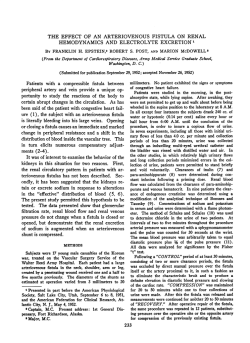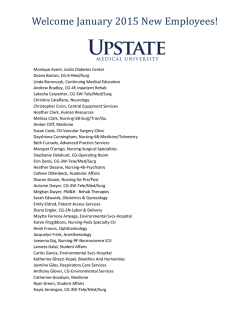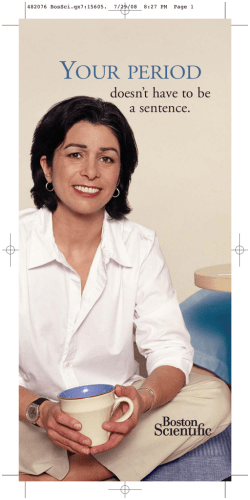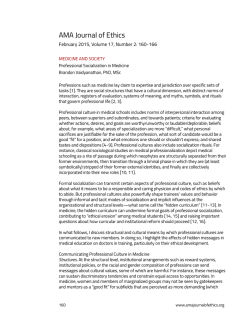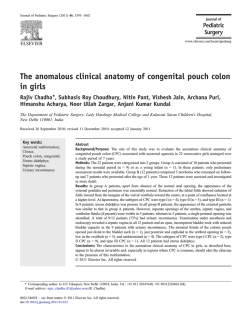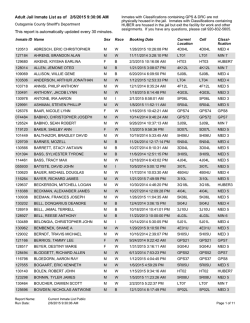
Download [ PDF ] - journal of evidence based medicine and
CASE REPORT UNUSUAL CASE OF UTERO-ENTERIC FISTULA Tushar Palve1, R. G. Daver2, N. Goyal3 HOW TO CITE THIS ARTICLE: Tushar Palve, R. G. Daver, N. Goyal. ”Unusual Case of Utero-Enteric Fistula”. Journal of Evidence based Medicine and Healthcare; Volume 2, Issue 5, February 2, 2015; Page: 587-591. ABSTRACT: Dilatation and curettage is one of the common minor procedures with minimal complication but can it cause major complications like perforation of uterus, so we are reporting on a case of utero enteric fistula followed by perforation. INTRODUCTION: Dilatation and curettage is one of the common minor gynaecological procedure but not without major complications. Uterine perforation is one example of such complication for which conservative management is generally recommended but in some cases it may require surgical intervention. Here we are sharing one such experience of a patient who presented as the case of secondary infertility with symptom of intermittent abdominal pain and finally diagnosed as the case of utero-enteric fistula after undergoing further workup. CASE HISTORY: A 30 years female patient, married since 15 years, P1L1A1 Presented to our OPD with a history of secondary infertility with HSG report. Fig. 1 & 2 HSG S/o: Injected dye in bowel. Fistulous communication of uterus with bowel. Right fallopian tube not visualized. Left fallopian tube normal. Patient was posted for Diagnostic Hystero Laparoscopy after investigation: Laparoscopic findings: 1. Ut normal size 2. Mild hydrosalpinx on left side 3. Loop of small intestine adherant to fundus of Uterus on its posterior part. J of Evidence Based Med & Hlthcare, pISSN- 2349-2562, eISSN- 2349-2570/ Vol. 2/Issue 5/Feb 02, 2015 Page 587 CASE REPORT Hysteroscopic findings: 1. B/L ostiavisualised 2. Endometrium polypoidal 3. Vertical incomplete septum from fundus Chromopertubation: 1. B/L spill absent 2. Bluish discoloration of bowel loop 3. Dye & hysteroscopic fluid found in rectum And then planned for exploratory laparotomy and findings were: Exploratory laparotomy In situ findings 1. Intestinal loop was pulled into fundus of uterus more towards posterior part. 2. There was a fistula between Ileum aprox 6 inches from ileoceacal junction, Uterus & sigmoid colon. Loop of ileum, sigmoid colon separated from uterine fundus by sharp dissection. Fistulous communication in ileum & sigmoid colon sutured with vicryl 3-0 &mersilk 2-0 in two layers after refreshing the edges. Patency of bowel checked- bowel patent. Uterine end of fistula closed with vicryl 3-0. Fig. 3, 4, 5 and 6 J of Evidence Based Med & Hlthcare, pISSN- 2349-2562, eISSN- 2349-2570/ Vol. 2/Issue 5/Feb 02, 2015 Page 588 CASE REPORT Post operatively: Started on higher antibiotics with adequate hydration patient kept NBM for 72 hrs abdominal drain removed on day 5 Suture removals done on day 10 scar healthy. Fig. 7: Bilateral tubal block Patient was discharged on 16/09/11HPR of bowel margins: chronic inflammation. In view of bilateral tubal block planned for IVF. DISCUSSION: D&C is a diagnostic and therapeutic surgical procedure used frequently with overall low complication rate of 0.7%.1 The rate of perforation varies with the indication for the same. The perforation is more common when attempting for control of post-partum haemorrhage (5.1%) and less common for diagnostic curettage (0.3% in premenopausal and 2.6% in postmenopausal patient).2, 3 In the case of the uterus, perforation ending in fistula can develop into the bladder, colon, and small intestine. Enterouterine fistulas occur infrequently. Martin et al.4 published perhaps the largest review of enterouterine fistulas in 1956 which described 80 cases, 42 of which, followed obstetric injury, 17 resulting from inflammatory processes, 12 following curettage, and 9 related to carcinoma In particular, ileo-uterine fistulas are rare. McFarlane et al.5 described a jejuno-uterine fistula that developed two weeks after dilatation and curettage performed for severe postpartum hemorrhage. Duttaroy et al.6 described symptoms of a jejuno-uterine fistula developing 3 months after dilation and evacuation for a spontaneous abortion. Singh et al.7 described a chronic jejunouterine fistula following termination of pregnancy, discovered after 3 consecutive abortions. Vohra et al.8 described a jejuno-uterine fistula occurring 6 weeks after curettage for retained products of conception. Simon D. Eiref et al.9 described Jejuno-Uterine Fistula after Endovascular Embolization For Uterine Bleeding All cases were managed by surgical repair. CONCLUSION: In conclusion we must consider certain aspects of the D&C procedure. D&C is performed in a “blind” manner, meaning that it depends on tactile feedback to the operator. Experience and skill of individual providers are essential for a safe D&C. Most uterine perforations escape a medical detection without hemorrhage or visceral injury. Perforations are more likely to be troublesome if the perforation is laterally located, the defect is more than 1.2 cm, they occur after first trimester, or they are associated with a bowel injury. In most of cases, the perforation J of Evidence Based Med & Hlthcare, pISSN- 2349-2562, eISSN- 2349-2570/ Vol. 2/Issue 5/Feb 02, 2015 Page 589 CASE REPORT is recognized by the operator during the procedure. However, in many cases, perforations may remain clinically undiagnosed and the patients were discharged. Some of these patients present subsequently with serious complications.10 Only a small percentage of women with perforation suffer intestinal prolapse. Although the training level of the caregivers may also be a risk factor of intestinal prolapse,11 it is not known whether intestinal prolapse is caused by chance or some other risk factors. Augustin et al.12 stated “we recommended publishing of every case on the subject for construction of more precise diagnostic and therapeutic algorithm” with which we agree. This may allow for the future establishment of guidelines for dealing with this condition. REFERENCES: 1. Gakhal MS, Levy HM. Sonographic diagnosis of extruded fetal parts from uterine perforation in the retroperitoneal pelvis after termination of intrauterine pregnancy that were occult on magnetic resonance imaging J Ultrasound Med. 2009;28(12): 1723-1727. 2. Ben-Baruch G, Menczer J, Shalev J, Romem Y, Serr DM. Uterine perforation during curettage: perforation rates and postperforation management. Isr J Med Sci. 1980;16(12): 821-824. 3. Grossman D, Blanchard K, Blumenthal P. Complications after second trimester surgical and medical abortion. Reprod Health Matters. 2008;16(31 Suppl): 173-182. 4. Martin DH, Hixson CH, Wilson EC Jr. Enterouterine fistula; review; report of an unusual case. Obstet Gynecol. 1956 Apr;7(4): 466- 9. 5. McFarlane MEC, Plummer JM, Remy T, Christie L, Laws D, Richard H, Cherrie T, Edwards R. Coward C. Jejunouterine fistula: a case report. Gynecol Surg (2008) 5: 173–175. 6. Duttaroy D. Jejuno-uterine fistula. European Journal of Obstetrics & Gynecology and Reproductive Biology 129 (2006) 92–99. 7. Singh RB, Pavithran NM, Parameswaran RM, Sangwan K. Chronic jejuno-uterine fistula: an unusual cause for recurrent second trimester abortions. Aust N Z J Obstet Gynaecol 2005 45(6);533-534. 8. Vohra PA, Kumar Y, Raniga S, Vaidya V, Verma S, Mehta CA Case Of Jejunouterine Fistula Ind J Radiol Imag 2005 15: 4: 427-428 9. Eiref SD, Holekamp S, Koulos J, Levi G, Winestone M, Kagen A, and Leitman IM. Jejunouterine fistula after endovascular embolization for uterine bleeding. J Surg Radiol. 2010 Oct 1;1(2). 10. Chauhan NS, Gupta A, Soni PK, Surya M, Mahajan SR. Iatrogenic uterine perforation with abdominal extrusion of fetal parts: a rare radiological diagnosis. J Radiol Case Rep. 2013;7(1):41-47. 11. Ntia O. and Ekele B. A. “Bowel prolapse through perforated uterus following induced abortion,” West African Journal of Medicine, 2000; 19(3):209–211,. 12. Augustin G, Majerović M, and Luetić T. “Uterine perforation as a complication of surgical abortion causing small bowel obstruction: a review,” Archives of Gynecology and Obstetrics, 2013;288(2):311–323. J of Evidence Based Med & Hlthcare, pISSN- 2349-2562, eISSN- 2349-2570/ Vol. 2/Issue 5/Feb 02, 2015 Page 590 CASE REPORT AUTHORS: 1. Tushar Palve 2. R. G. Daver 3. N. Goyal PARTICULARS OF CONTRIBUTORS: 1. Assistant Professor & Head of Unit, Department of Obstetrics and Gynaecology, Grant Government Medical College, Mumbai. 2. Professor and HOD, Department of Obstetrics and Gynaecology, Grant Government Medical College, Mumbai. 3. Assistant Professor, Department of Obstetrics and Gynaecology, Grant Government Medical College, Mumbai. NAME ADDRESS EMAIL ID OF THE CORRESPONDING AUTHOR: Dr. Tushar Palve, F2, Marian House, 29th Road of Waterfield Road, Bandra West, Mumbai. E-mail: [email protected] Date Date Date Date of of of of Submission: 16/08/2014. Peer Review: 17/08/2014. Acceptance: 10/11/2014. Publishing: 30/01/2015. J of Evidence Based Med & Hlthcare, pISSN- 2349-2562, eISSN- 2349-2570/ Vol. 2/Issue 5/Feb 02, 2015 Page 591
© Copyright 2024
![Download [ PDF ] - journal of evolution of medical and dental sciences](http://s2.esdocs.com/store/data/000488959_1-4dca276881c4179da54bcce462126ef6-250x500.png)
